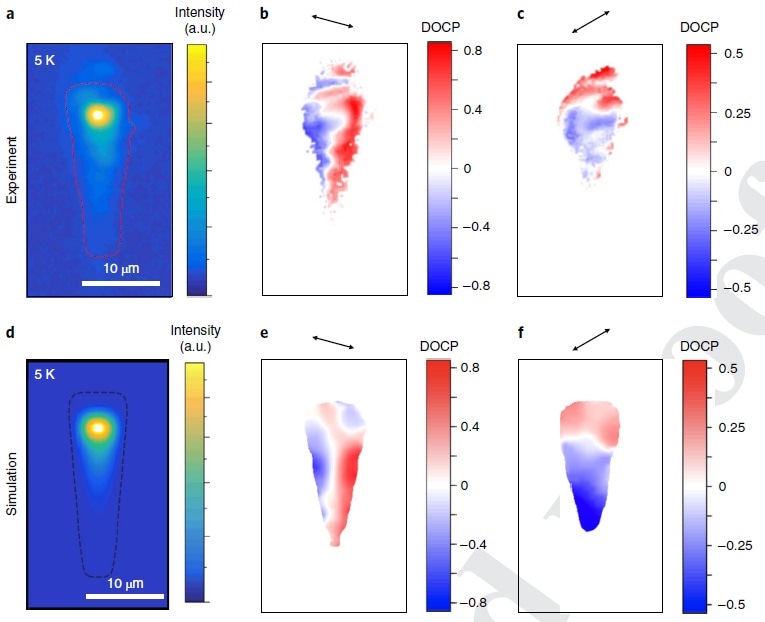Jul 24 2019
An international team of researchers has investigated how photons move in the plane of the thinnest semiconductor crystal in the world. It was found that the distribution of light polarization in space was similar to the three-colored rapana.
 As the scientists noted, the graph that shows the spatial distribution of the polarization of light turned out to be rather unusual—it resembles a multi-colored marine rapana. (Image credit: Nature Nanotechnology)
As the scientists noted, the graph that shows the spatial distribution of the polarization of light turned out to be rather unusual—it resembles a multi-colored marine rapana. (Image credit: Nature Nanotechnology)
The study outcomes open the doors to the development of monoatomic optical transistors—components for quantum computers that have the ability to perform calculations at the speed of light. The study has been published in Nature Nanotechnology.
Transistors can be seen in every modern microcircuit concealed within a laptop or smartphone. These are small semiconductor devices controlling the flow of electric current, or the electron flow. By substituting electrons in the place of photons (elementary particles of light), researchers can potentially create new computing systems with the ability to process enormous information flows at a speed close to that of light.
Currently, photons are regarded best suited for transmitting information in quantum computers. These computers are still hypothetical, work based on the laws of the quantum realm, and can solve some problems more efficiently when compared to the most robust supercomputers.
There are no basic limits for developing quantum computers, but researches have still not selected the material platform that will be the most effective and convenient for executing the concept of a quantum computer. At present, cold atoms, superconducting circuits, defects in diamond, ions, and other systems compete for being selected for the future quantum computer.
The two-dimensional crystals and the semiconductor platform have now been achieved, particularly, due to the efforts by researchers at the University of Würzburg (Germany), the University of Southampton (United Kingdom), the University of Grenoble Alpes (France), the University of Arizona (USA), the Westlake University (China), the Ioffe Physical-Technical Institute of the Russian Academy of Sciences, and St Petersburg University.
The physicists investigated the movement of light in a 2D crystal layer of molybdenum diselenide (MoSe2). This compound is just one atom thick—the world’s thinnest semiconductor crystal. It was discovered that the polarization of light that propagates in a superfine crystalline layer is dependent on the light propagation direction.
This phenomenon is caused by the effects of spin-orbit interaction within the crystal. Fascinatingly, as the researchers observed, the graph that illustrates the spatial distribution of the polarization of light was found to be quite unusual—it looks like a multi-colored marine rapana.
For the experiments, ultrafine molybdenum diselenide crystals were produced in the lab of Professor Sven Höfling from the University of Würzburg, which is one of the best crystal growth labs in Europe. Measurements were performed in Würzburg and in St Petersburg under the supervision of Alexey Kavokin, professor at St Petersburg University.
Mikhail Glazov, a corresponding member of the Russian Academy of Sciences, a leading research associate at the Ioffe Physical-Technical Institute, and an employee of the Spin Optics Laboratory at St Petersburg University, played a vital role in the development of the theoretical base.
“I foresee that in the near future, two-dimensional monoatomic crystals will be used to transfer information in quantum devices,” stated Professor Alexey Kavokin, Head of the Spin Optics Laboratory at St Petersburg University.
What classic computers and supercomputers take a very long time to do, a quantum computing device will do very quickly. Therein lies the great danger of quantum technologies—comparable to the danger of an atomic bomb. With their help it will be possible, for example, to hack banking protection systems very quickly. That is why today intensive work is under way, including the creation of means of protecting quantum devices: quantum cryptography. And our work contributes to semiconductor quantum technologies.
Alexey Kavokin, Professor, Head of the Spin Optics Laboratory, St Petersburg University
Moreover, according to the researchers, the study is a huge step forward in the investigation of light-induced (i.e. appearing in the presence of light) superconductivity. It is the phenomenon that occurs when materials that permit electric current to pass through exhibit zero resistance.
Currently, it is not possible to achieve this state at temperatures above −70 °C. However, upon finding the proper material, this invention will render it feasible to transfer electricity to any point on Earth without any loss, as well as to develop a new generation of electric motors.
A point to be remembered is that in March 2018, the research group of Alexey Kavokin predicted that structures consisting of superconducting metals, like aluminum, can be helpful in overcoming the challenge. Currently, researchers at St Petersburg University are striving to find a means to acquire experimental evidence for their theory.